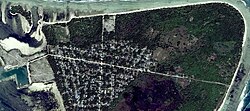Meedhoo (Addu)
|
Meedhoo މީދޫ |
|
|---|---|
| Inhabited island | |
 |
|
| Location in Maldives | |
| Coordinates: 0°35′01″S 73°14′03″E / 0.583724°S 73.234041°ECoordinates: 0°35′01″S 73°14′03″E / 0.583724°S 73.234041°E | |
| Country | Maldives |
| Geographic atoll | Addu Atoll |
| Administrative atoll | Addu City |
| Area | |
| • Total | 2.0495 km2 (0.7913 sq mi) |
| Dimensions | |
| • Length | 2.350 km (1.460 mi) |
| • Width | 1.625 km (1.010 mi) |
| Population (2013) | |
| • Total | 2,806 |
| • Density | 1,400/km2 (3,500/sq mi) |
| Time zone | MST (UTC+05:00) |
Midu (Meedhoo) (Dhivehi: މީދޫ) is the oldest populated island in Addu Atoll (also known as Seenu Atoll) in the Republic of Maldives, having been settled between 1000 and 500 BCE. Its name comes from the original Indo-Aryan settlers; Meedhoo means "Big Island" in Sanskrit. Meedhoo is located in the northernmost tip of Addu Atoll.
The original settlers were Divehi people of Aryan origin. An Arab traveller by the name of Yoosuf Naib planted the seed of Islam and built a place to worship Allah in the 12th century; this became the country's first mosque. The island has since been known as a centre of learning and Islamic religious education, famous for the scholars it has produced. Since the 16th century, eight natives of Meedhoo have served as fandiyaaru, or qazi, at Malé. To this day, Meedhoo's Ulamma and other ecclesiastics hold their own with those of the capital.
Meedhoo is one of the largest islands in the Maldives. Despite its distance from the capital Malé and its comparatively small population, Meedhoo has maintained a disproportionate importance in Maldivian affairs.
The oldest cemetery in the Maldives, Kōgaṇṇu, is located in Meedhoo.
Fen'aa Avashu and Dheshenaa Avashu are the main two districts of Meedhoo. Dheshenaa Avashu lies to the north, while Fen'aa Avashu lies to the south.
...
Wikipedia

